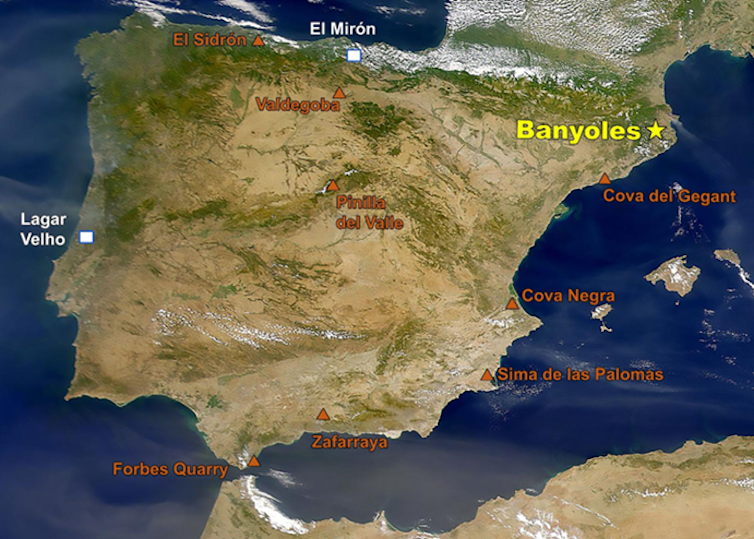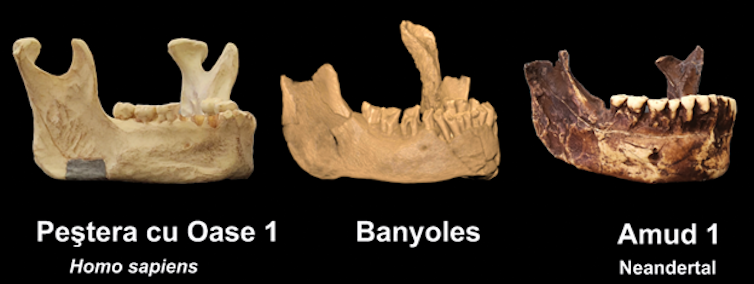
Close examination of digital and 3D-printed models suggested the fossil needs to be reclassified. (Photo: Brian A. Keeling)
Homo sapiens, our own species, evolved in Africa sometime between 300,000 and 200,000 years ago. Anthropologists are pretty confident in that estimate, based on fossil, genetic and archaeological evidence.
Then what happened? How modern humans spread throughout the rest of the world is one of the most active areas of research in human evolutionary studies.
The earliest fossil evidence of our species outside of Africa is found at a site called Misliya cave, in the Middle East, and dates to around 185,000 years ago. While additional H. sapiens fossils are found from around 120,000 years ago in this same region, it seems modern humans reached Europe much later.
Understanding when our species migrated out of Africa can reveal insights into present-day biological, behavioral and cultural diversity. While we Homo sapiens are the only humans alive today, our species coexisted with different human lineages in the past, including Neanderthals and Denisovans. Scientists are interested in when and where H. sapiens encountered these other kinds of humans.
Our recent reanalysis of a fossil jawbone from a Spanish site called Banyoles is raising new questions about when our species may have migrated to Europe.
Homo sapiens fossils found in Europe
The first documented discoveries of human fossils were in Europe, just before Darwin's 1859 publication of "The Origin of Species." Ideas of evolution were being actively debated within European universities and scientific societies.
Many of the earliest fossil findings were Neanderthals, a species that evolved in Europe by 250,000 years ago and became extinct around 40,000 years ago. They are also our closest evolutionary relatives and, because of ancient interbreeding, the genomes of people today include Neanderthal DNA. Because of their early historical presence, Neanderthal fossils had a big influence on how early researchers thought about human evolution.
The first fossil evidence of Neanderthals was found in 1856 during quarrying activities from the Neander Tal (Neander Valley) in Germany. Paleontologists took the hint and started to search for human fossils in other caves and exposed areas that preserved ancient sediments.
More than a decade later, in 1868, paleontologists uncovered H. sapiens fossils at the site of Cro-Magnon in southern France. For much of the 20th century, the 30,000-year-old Cro-Magnon fossils represented the earliest fossil evidence of our species in Europe.
More recently, evidence for an earlier H. sapiens presence in Europe has come from two sites in Eastern Europe, including a partial skull from Zlatý kůň Cave in Czechia dating to 45,000 years ago, as well as more fragmentary remains from Bacho Kiro Cave in Bulgaria dating to around 44,000 years ago. Ancient DNA analysis has confirmed that the fossils from these sites represent H. sapiens. Additional, potentially earlier, evidence is represented by a single tooth dating to 54,000 years ago from the Grotte Mandrin Cave in France.
This is where the human fossil from Banyoles comes into the story.
Reinvestigating a 'Neanderthal' mandible
Over a century ago in 1889, a fossil human lower jaw, or mandible, was found at a quarry near the town of Banyoles, in northeastern Spain. Pere Alsius, a prominent local pharmacist, first studied the mandible, and the fossil has been curated by his family ever since.
A number of anthropologists have studied the fossil over time, but it has not usually been included in discussions about H. sapiens in Europe. Most researchers instead argued it represented a Neanderthal or showed Neanderthal-like features, in part because the Banyoles fossil lacks a feature considered typical and diagnostic of our own species: a bony chin on the front of the mandible.
Researchers did not have a good idea of how old the Banyoles mandible was, with most believing it likely dated to the Middle Pleistocene (780,000-130,000 years ago). That age made it seem too old to represent H. sapiens. Thus, with the absence of a chin and the presumed early date, the designation as a Neanderthal seemed to make sense.

Map of the Iberian Peninsula indicating where the Banyoles mandible (yellow star) was found, along with Late Pleistocene Neanderthal (orange triangles) and H. sapiens (white squares) sites. (Photo: Brian A. Keeling)
Based on recent modern uranium-series and electron spin resonance dating, researchers now believe the Banyoles mandible is between 45,000 and 66,000 years old. This younger estimate overlaps with the early H. sapiens fossils from Eastern Europe.
Working with Spanish paleoanthropologists and archaeologists, we took another look at what species the fossil might represent. We relied on a CT scan to virtually reconstruct damaged or missing portions of the mandible and generated a 3D model of the complete fossil. Then, we studied its overall shape and distinctive anatomical features, comparing it to H. sapiens, Neanderthals and other earlier human species.

Virtual reconstruction of the 3D model of the Banyoles mandible. Highlighted piece in blue indicates a mirrored element that researchers used to fill out missing sections. (Photo: Brian A. Keeling)
In contrast to earlier analyses, our results revealed that the Banyoles jawbone was most similar to H. sapiens fossils – not Neanderthals.
When we examined the mandible's bony features where muscle tendons and ligaments would have attached, it most closely resembled H. sapiens. We also found no unique bony features shared with the Neanderthals. Additionally, when we used sophisticated 3D analysis techniques, we found that Banyoles' overall shape was a better match with H. sapiens than with Neanderthal individuals.
While nearly all of our evidence suggests this prehistoric human was indeed a member of our species, the lack of a chin remains puzzling. This feature is present in all human populations today and should be present in Banyoles if it is a member of our species.
Figuring out the closest match
How do we reconcile our results showing that Banyoles is a modern human with the fact that it lacks one of the most distinctive modern human features? We considered several possible scenarios.
When the mandible was discovered, it was still encased in a hard travertine block and only partially exposed. During initial cleaning and preparation of the specimen, it was accidentally dropped and the chin region was damaged. The fossil was subsequently reconstructed, with the damaged fragments aligned in their correct anatomical position, and the current state of the fossil does seem to accurately reflect an original chinless shape. Thus, the lack of a chin in Banyoles cannot be attributed to this initial incident.
Could the lack of a chin in the Banyoles fossil be a result of interbreeding with Neanderthals, who also lacked a chin? Genetic evidence suggests that H. sapiens most likely interbred with Neanderthals between 45,000 and 65,000 years ago, making this a possibility.
To assess this hypothesis, we compared Banyoles with an early H. sapiens mandible dating to about 42,000 years ago from a Romanian site called Peştera cu Oase. Ancient DNA analysis has revealed that the Oase individual had a Neanderthal ancestor between four and six generations back, making it close to a hybrid individual. However, unlike Banyoles, this mandible shows a full chin along with some other Neanderthal features. Since Banyoles shared no distinctive features with Neanderthals, we ruled out the possibility of this individual representing interbreeding between Neanderthals and H. sapiens.

Comparison of mandibles between H. sapiens, at left; Banyoles, center; and a Neanderthal, at right. (Photo: Brian A. Keeling)
We're left with two possibilities. Banyoles may represent a hybrid individual between H. sapiens and a non-Neanderthal archaic human lineage. This scenario might account for the absence of the chin as well as the lack of any other Neanderthal features in Banyoles. However, scientists haven't identified any such non-Neanderthal archaic group in the fossil record of the European Late Pleistocene (129,000-11,700 years ago), making this hypothesis less likely.
Alternatively, Banyoles may document a previously unknown lineage of largely chinless H. sapiens in Europe. Possible support for this hypothesis comes from the fact that early H. sapiens fossils from Africa and the Middle East show a less prominent chin than do living humans.
Additionally, ancient DNA research has shown that H. sapiens populations in Europe before 35,000 years ago did not contribute to the modern European gene pool. Thus, we believe the least unlikely hypothesis is that Banyoles represents an individual from one of these early H. sapiens populations.
Our study of Banyoles demonstrates how new discoveries about our evolutionary past do not solely rely on new fossil discoveries, but can also come about through applying new methodologies to previously discovered fossils. If Banyoles is really a member of our species, it would potentially represent the earliest H. sapiens lineage documented to date in Europe. Future ancient DNA analysis could confirm or refute this surprising result. In the meantime, the 3D model of Banyoles is available for other researchers to study and form their own conclusions.![]()
Brian Anthony Keeling is a Doctoral Candidate in Anthropology at Binghamton University, State University of New York and Rolf Quam is Associate Professor of Anthropology at Binghamton University, State University of New York. This article is republished from The Conversation under a Creative Commons license.













